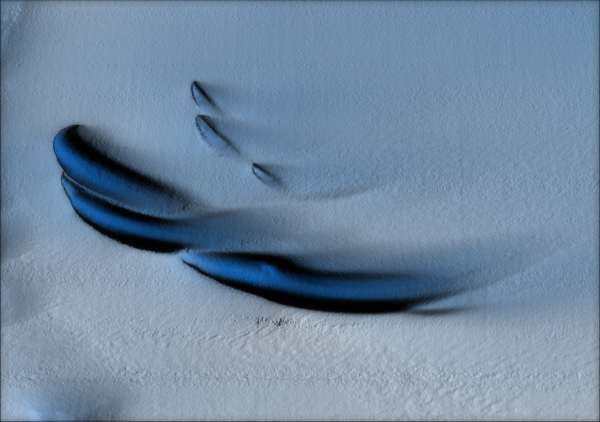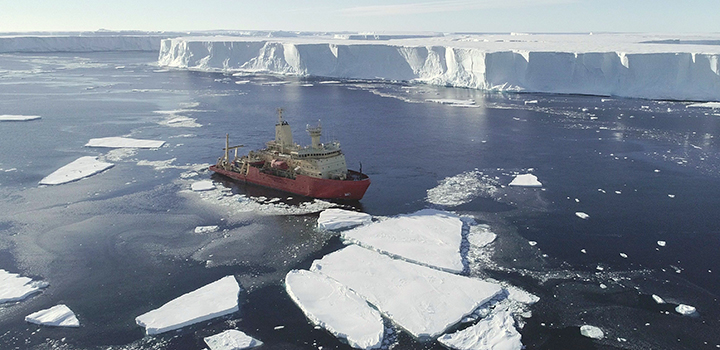Underwater mapping reveals new insights into melting of Antarctica's ice shelves
By: Communications

Clues to future sea level rise have been revealed by the first detailed maps of the underside of a floating ice shelf in Antarctica.
An international research team - including scientists from the University of East Anglia (UEA) - deployed an unmanned submersible beneath the Dotson Ice Shelf in West Antarctica.
The underwater vehicle, ‘Ran’, was programmed to dive into the cavity of the 350metre-thick ice shelf and scan the ice above it with an advanced sonar. Over 27 days, the submarine travelled more than 1000 kilometres back and forth under the shelf, reaching 17 kilometres into the cavity.
An ice shelf is a mass of glacial ice, fed from land by tributary glaciers, that floats in the sea above an ice shelf cavity. Dotson Ice Shelf is part of the West Antarctic ice sheet - and next to Thwaites Glacier - which is considered to have a potentially large impact on future sea level rise due to its size and location.
The researchers report their findings of this unique survey in a new paper published today in the journal Science Advances.
They found some things as expected, for example the glacier melts faster where strong underwater currents erode its base. Using the submersible, they were able to measure the currents below the glacier for the first time and prove why the western part of Dotson Ice Shelf melts so fast. They also found evidence of very high melt at vertical fractures that extend through the glacier.

One of the images captured of the underside of the ice shelf. Credit: Filip Stedt
However, the team also saw new patterns on the glacier base that raise questions. The mapping showed that the base is not smooth, but there is a peak and valley ice-scape with plateaus and formations resembling sand dunes. The researchers hypothesize that these may have been formed by flowing water under the influence of Earth's rotation.
Lead author Anna Wåhlin, Professor of Oceanography at the University of Gothenburg in Sweden, said: "We have previously used satellite data and ice cores to observe how ice shelves change over time. By navigating the submersible into the cavity, we were able to get high resolution maps of the ice underside. It's a bit like seeing the back of the moon for the first time.”
The expedition was carried out in regions of drifting ice in West Antarctica in 2022 during a research cruise for the TARSAN project, a joint US-UK funded initiative that is part of the International Thwaites Glacier Collaboration. The project is studying how atmospheric and oceanic processes are influencing the behaviour of the Thwaites and Dotson Ice Shelves – neighbouring ice shelves which are behaving differently.

A graphic explaining how the survey mission was carried out. Credit: Anna Wåhlin
Co-author Dr Rob Hall, from UEA’s School of Environmental Sciences, co-led the cruise on the RV Nathaniel B Palmer, on which the observations were made in January to March 2022. He said: “Anna and her team successfully piloted their autonomous underwater vehicle ‘Ran' over 1000 km under Dotson Ice Shelf collecting a huge range of data and samples, which will take several years to process and analyse.
“The incredible high-resolution images of the underside of the ice shelf are the icing on the cake and will open up a whole new avenue of scientific research.”
Prof Karen Heywood, also from UEA and a co-author, is UK lead scientist on the TARSAN project. She said: “This has been such an exciting project to work on. When Anna sent round the first images of the underside of the Dotson ice shelf we were thrilled – nobody had ever seen this before. But we were also baffled – there were cracks and swirls in the ice that we weren’t expecting. It looked more like art!
“We wondered what could be causing these. All of the glaciologists and the oceanographers in the TARSAN project got together to brainstorm ideas. It’s been like detective work – using fundamental ocean physics to test theories against the shape and size of the patterns under the ice. We’ve been able to show for the first time some of the processes that melt the underside of ice shelves.
Prof Heywood added: “These ice shelves are already floating on the sea, so their melting doesn’t directly affect sea level. However ultimately the melting of ice shelves causes the glaciers on land further upstream to flow faster and destabilise, which does lead to sea level rise, so these new observations will help the community of ice modellers to reduce the large uncertainties in future sea level.”

The underwater vehicle, ‘Ran’, floats in icy water. Credit: Filip Stedt
Scientists now realise there is a wealth of processes left to discover in future research missions under the glaciers.
“The mapping has given us new data that we need to look at more closely. It is clear that many previous assumptions about melting of glacier undersides are falling short. Current models cannot explain the complex patterns we see. But with this method, we have a better chance of finding the answers,” said Prof Wåhlin.
“Better models are needed to predict how fast the ice shelves will melt in the future. It is exciting when oceanographers and glaciologists work together, combining remote sensing with oceanographic field data. This is needed to understand the glaciological changes taking place – the driving force is in the ocean.”
In January 2024, the group returned with Ran to Dotson Ice Shelf to repeat the surveys, hoping to document changes. However, they were only able to complete one dive before Ran disappeared under the ice.
“Although we got valuable data back, we did not get all we had hoped for,” said Prof Wåhlin. “These scientific advances were made possible thanks to the unique submersible that Ran was. This research is needed to understand the future of Antarctica's ice sheet, and we hope to be able to replace Ran and continue this important work.”
‘Swirls and scoops: Ice-base melt revealed by multibeam imagery of an Antarctic ice shelf’, Anna Wåhlin et al, is published in Science Advances on July 31.
Find out more about Clearing and view available courses
Related Articles

Southern Ocean absorbing more CO2 than previously thought
New research led by the University of East Anglia and Plymouth Marine Laboratory (PML) has found that the Southern Ocean absorbs more carbon dioxide (CO2) than previously thought.
Read more
UEA scientists lead new mission to Antarctica’s remote Thwaites Glacier
A 65-day research missionusing a fleet of underwater robots to determine the impact of Thwaites Glacier on global sea-level rise,departed from Punta Arenas last week, ledby scientists from UEA, including Prof Karen Heywood andDr Robert Hall from the Schoo
Read more
Dr Matthew Jones wins 2025 Philip Leverhulme Prize
An environmental scientist from UEA has been awarded a prestigious research prize for his internationally recognised work on wildfires and climate change.
Read more